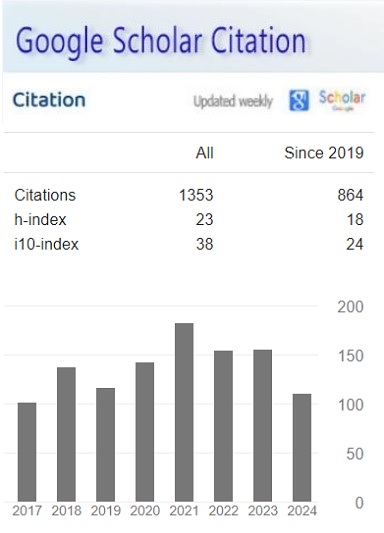Analysis of mobile phone radiation effect on human body using specific absorption rate
Keywords:
Abstract
The use of mobile phones is rising everyday both in civic and rustic areas in Bangladesh. Every mobile phone disperses electromagnetic energy. This radiation or electromagnetic wave can penetrate into the human body. Specific absorption rate and change in temperature are the vital parameter to find the dominant effects assess on the human body. This paper explores the radiation impact of mobile phones. A mathematical equation is used to evaluate the local specific absorption rate and change in temperature at Skin, Fat, Bone, Brain, Eye, Muscle tissues at the frequency of 800MHz, 900 MHz, 1800 MHz, 2100 MHz, 2.5GHz, 2.6GHz, 3.4GHz, 3.5GHz, and 3.6GHz. The calculations are performed at different distances and exposure times of mobile phone. A simple radio frequency detection circuit has been designed to find the radiated power of different frequency. The highest specific absorption rate is calculated for skin, brain, eye tissue. Child tissue absorption rate is higher than the adult. When the radiated power of mobile phone is high the specific absorption rate for different tissue cross the safety limit. This paper also recommends the ways to diminish the effects of SAR. It is suggested that these methods will decrease the health risks. This work will be very helpful to understand the bad effect of using mobile phones and the way of reducing this effect.
References
Zhao, K., Zhang, S., Ying, Z. and Bolin, T. (2013). SAR Study of Different MIMO Antenna Designs for LTE Application in Smart Mobile Phones. IEEE Transactions on Antennas and Propagation. 61(6): doi- 10.1109/TAP.2013.2250239.
Takei, R., Nagaoka, T., Saito, K. and Watanabe, S. 2017. SAR Variation Due to Exposure from a Smartphone Held at Various Positions Near the Torso. IEEE Transactions on Electromagnetic Compatibility. IEEE Transactions on Electromagnetic Compatibility. 59 (2):747-753.
Bhargava, D., Leeprechanon, N., Rattanadecho, P., Wessapan, T. 2019. Specific absorption rate and temperature elevation in the human head due to overexposure to mobile phone radiation with different usage patterns, International Journal of Heat and Mass Transfer. 130: 1178–1188.
Zhang, H. (2018). Electromagnetic-Thermal Analysis of Human Head Exposed to Cell Phones with the Consideration of Radiative Cooling. IEEE Antennas and Wireless Propagation Letters. 17(9):1584-1587.
Wessapan, T. and Rattanadecho, P. 2013. Specific absorption rate and temperature increase in the human eye due to electromagnetic fields exposure at different frequencies. International Journal of Heat and Mass Transfer, 64:426-435.
Mandapuram, M. (2016). Applications of Blockchain and Distributed Ledger Technology (DLT) in Commercial Settings. Asian Accounting and Auditing Advancement, 7(1), 50–57. Retrieved from https://4ajournal.com/article/view/76
Christopher, B., Khandaker, M.U. and Jojo, P.J. 2020. Empirical study on specific absorption rate of head tissues due to induced heating of 4G cell phone radiation. Radiation Physics and Chemistry 178: 190-196.
Wessapan, T., Srisawatdhisukul, S. and Rattanadecho, P. 2012. Specific absorption rate and temperature distributions in human head subjected to mobile phone radiation at different frequencies, International Journal of Heat and Mass Transfer 55: 347–359.
Mandapuram, M. (2017a). Application of Artificial Intelligence in Contemporary Business: An Analysis for Content Management System Optimization. Asian Business Review, 7(3), 117–122. https://doi.org/10.18034/abr.v7i3.650
Mandapuram, M. (2017b). Security Risk Analysis of the Internet of Things: An Early Cautionary Scan. ABC Research Alert, 5(3), 49–55. https://doi.org/10.18034/ra.v5i3.650
Wessapan, T., and Rattanadecho, P. 2012. Specific Absorption Rate and Temperature Increase in Human Eye Subjected to Electromagnetic Fields at 900 MHz. Journal of Heat Transfer. 134(9): 91-101.
Kaburcuk, F. 2019. Effects of a brain tumor in a dispersive human head on SAR and temperature rise distributions due to RF sources at 4G and 5G frequencies. Electromagnetic Biology and Medicine. 38(2):168-176.
Ezequiel, I., Espinosa, R., and Roberto L. M., 2018. Analysis of SAR distribution in a heterogeneous and homogenous head model at 2.4 GHz using the FDTD method” , Microwave and Optical Technology Letters, 60 (6):1323-1331.
Christopher, B., Sheena Mary, Y., Khandaker, M.U., and Jojo, P. 2021. Empirical study on specific absorption rate of head tissues due to induced heating of 4G cell phone radiation. Radiation Physics and Chemistry, 178, 108910.
Hoque, F., Hossain, S., Mollah, S. 2013. A study on specific absorption rate (SAR) due to non-ionizing radiation from wireless/telecommunication in Bangladesh American Journal of Physics and Applications. 1(3): 104-110
Wessapan, T., Srisawatdhisukul, S. and Rattanadecho, P. 2012. Specific absorption rate and temperature distributions in human head subjected to mobile phone radiation at different frequencies, International Journal of Heat and Mass Transfer 55: 347–359.
Mandapuram, M., & Hosen, M. F. (2018). The Object-Oriented Database Management System versus the Relational Database Management System: A Comparison. Global Disclosure of Economics and Business, 7(2), 89–96. https://doi.org/10.18034/gdeb.v7i2.657
Published
How to Cite
Issue
Section
License
Copyright (c) 2022 Asian Journal of Applied Science and Engineering

This work is licensed under a Creative Commons Attribution-NonCommercial 4.0 International License.








